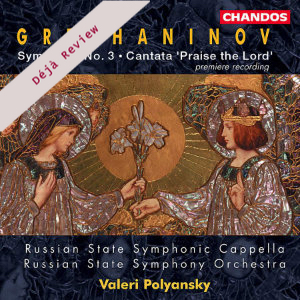
Déjà Review: this review was first published in October 2000 and the recording is still available.
Alexander Grechaninov (1864-1956)
Symphony No. 3, op. 100
Kvalite Boga(Praise The Lord), op. 65
Ludmila Kuznetsova (mezzo)
Russian State Symphonic Cappella
Russian State Symphony Orchestra/Valeri Polyansky
rec. 1998
Chandos CHAN9698 [66]
Grechaninov’s name is not totally unknown to music lovers. A number of his devotional choral pieces have always been in the repertoire of choirs. However his symphonies could not even be said to be peripheral. They fell off the edge of the known repertoire after securing a momentary toe-hold in the concert halls in the 1930s and 1940s.
Grechaninov’s Russian birthright glows from the pages of his music. No revolutionary he, Grechaninov gloried in the Russian nationalism of Borodin and Rimsky-Korsakov. Neither Communism nor Dodecaphony held any glamour for him. His alienation charted its way in fourteen years (1925-39) in Paris and then emigration to the USA where he spent the rest of his life. For him there was no return; in that respect he was unlike Prokofiev. He died at age 93 in New York.
His works are extensive. There is a great deal of music for children, operas, chamber music and songs. The five symphonies date 1894-1936.
Tchaikovskian blood flowing through the veins warms the flesh of Grechaninov’s Third. The work was premiered in Kiev in 1923, the year before the composer left for Paris. At 6.20 in the first movement one of those gracious nostalgic flute melodies of which Glazunov was a pastmaster floats by in eloquent confidence. The second movement makes equally poignant use of the upper woodwind. I was reminded somewhat of Madetoja’s Second Symphony which also has Tchaikovskian leanings. The rolling and carolling woodwind of the andante sounds like a relaxed version of Schumann (Rhenish Symphony) with a dash of Elgar. Grechaninov writes consistently very well for the woodwind. The antiphonal effects of the finale are wonderfully unstuffy although the insurgence at 3.07 of a sub-Rimsky ‘rumpus’ is not the strongest part of the symphony.
The cantata, in contrast with the smooth ‘Establishment’ ring of the other two masses, is a much more clearly Russian work. It is a masterpiece of elation and exalted peaks. The rapt inwardness of the cries of ‘Vruju’ from Janacek’s Glagolitic Mass, Vaughan Williams’ Magnificat and something of the singing swing of Paul Paray’s St Joan Mass (wonderfully done by James Paul on Reference) comes across in Grechaninov’s work. Time after time the composer comes up with inspired music. The regal vision and rippling motion of the final panel of the triptych is a remarkable inspiration with significant roles for the flute and trumpet. A wonderful discovery.
Once again the recording is crisp and punchy with enough space around the voices and orchestra to flatter the grand scale of Grechaninov’s vision.
Rob Barnett
Help us financially by purchasing from





















